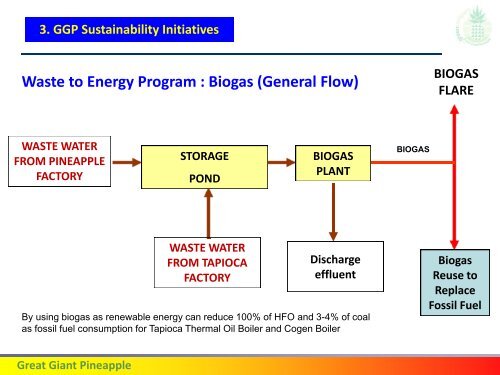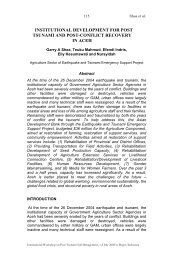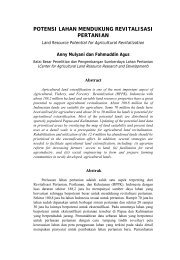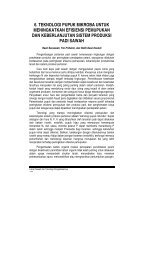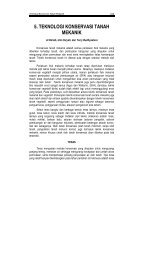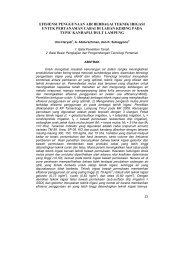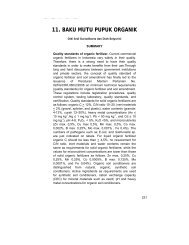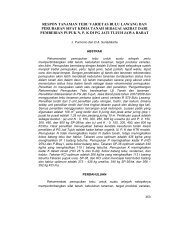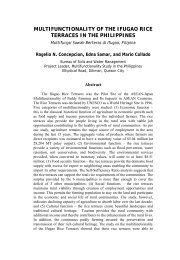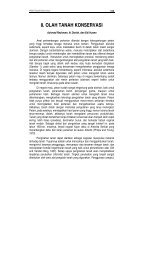II.1.PT GGP-Sustainability for Blue Ecomomi-2 kirim.pdf
II.1.PT GGP-Sustainability for Blue Ecomomi-2 kirim.pdf
II.1.PT GGP-Sustainability for Blue Ecomomi-2 kirim.pdf
You also want an ePaper? Increase the reach of your titles
YUMPU automatically turns print PDFs into web optimized ePapers that Google loves.
3. <strong>GGP</strong> <strong>Sustainability</strong> Initiatives<br />
Waste to Energy Program : Biogas (General Flow)<br />
WASTE WATER<br />
FROM PINEAPPLE<br />
FACTORY<br />
Great Giant Pineapple<br />
STORAGE<br />
POND<br />
WASTE WATER<br />
FROM TAPIOCA<br />
FACTORY<br />
BIOGAS<br />
PLANT<br />
Discharge<br />
effluent<br />
By using biogas as renewable energy can reduce 100% of HFO and 3-4% of coal<br />
as fossil fuel consumption <strong>for</strong> Tapioca Thermal Oil Boiler and Cogen Boiler<br />
BIOGAS<br />
BIOGAS<br />
FLARE<br />
Biogas<br />
Reuse to<br />
Replace<br />
Fossil Fuel
Organic Solid Waste Management (Closed Cycle)<br />
Fiber<br />
Cassava<br />
Peel<br />
Bamboo<br />
chopped<br />
3. <strong>GGP</strong> <strong>Sustainability</strong> Initiatives<br />
Tapioca<br />
Factory<br />
Cattle<br />
Feed<br />
Cow<br />
Dung<br />
Great Giant Pineapple<br />
Fiber<br />
Fiber<br />
Cassava Root<br />
from Farmers<br />
COMPOSTING PROCESS<br />
Concen‐<br />
trate<br />
Process<br />
Bromelain<br />
Enzyme<br />
Factory<br />
PJC<br />
CPC<br />
Pineapple stem<br />
Pineapple core<br />
Pineapple peel<br />
Pineapple<br />
Factory<br />
PINEAPPLE<br />
PLANTATION
3. <strong>GGP</strong> <strong>Sustainability</strong> Initiatives<br />
C<br />
O<br />
M<br />
P<br />
O<br />
S<br />
T<br />
Great Giant Pineapple<br />
Compost is as source of organic matter <strong>for</strong> soil<br />
that have benefits :<br />
1. Improving soil structure, it will make better<br />
roots distribution in the soil<br />
2. Increasing CEC, it will make better nutrient<br />
absorption by the roots<br />
3. Increasing water holding capacity, it will<br />
make availability of water in the soil during<br />
dry season<br />
4. Increasing biodiversity in the soil<br />
5. Increasing nutrients <strong>for</strong> the plant in the soil
3. <strong>GGP</strong> <strong>Sustainability</strong> Initiatives<br />
Great Giant Pineapple<br />
B<br />
I<br />
O<br />
G<br />
A<br />
S
3. <strong>GGP</strong> <strong>Sustainability</strong> Initiatives<br />
Liquid Organic Bio‐fertilizer (LOB) Plant<br />
LOB is the source of organic matter and phyto‐hormone<br />
Great Giant Pineapple
LOB Application on C4 Plant (Sorghum and Sweet Corn)<br />
Application in Shorghum<br />
(uni<strong>for</strong>m grain mature)<br />
Without LOB : Sorghum<br />
grain mature is not uni<strong>for</strong>m<br />
Great Giant Pineapple<br />
Corn (application with chemical fertilizer reduction)<br />
Root system of sprghum A (with LOB), K (control)
Waste Water<br />
Biogas (4% of coal,<br />
100% of HFO)<br />
Great Giant Pineapple<br />
Renewable Energy Use<br />
(Fossil Fuel Replacement :<br />
HFO – 100% & Coal – 14%)<br />
+ Fuel<br />
Palm Shell (10% of coal)<br />
F u e l<br />
Co‐gen Plant<br />
Thermal Oil Boiler
Fossil Fuel Replaced by Renewable Energy (Biogas & Palm Shell)<br />
Month<br />
Great Giant Pineapple<br />
% of Coal Replaced by<br />
Biogas & Palm Shell in<br />
Co‐gen Plant<br />
% of HFO Replaced<br />
by Biogas in Tapioca<br />
Factory<br />
Jan ‐ 40.0<br />
Feb ‐ 86.0<br />
Mar 2.5 90.0<br />
Apr 2.3 100.0<br />
May 3.3 100.0<br />
Jun 5.6 100.0<br />
Jul 9.3 100.0<br />
Aug 6.3 99.8<br />
Sep 6.4 100.0<br />
Oct 9.5 100.0<br />
Nov 9.4 100.0<br />
Dec 11.5 96.0
Vermicompost Project : Worm Propagation<br />
Great Giant Pineapple<br />
Worm<br />
Shelter<br />
Worm<br />
culture<br />
batch<br />
Batch tray<br />
Drainage
Media Preparation<br />
Great Giant Pineapple<br />
Fresh<br />
Cowdung<br />
Banana fruit<br />
Waste & Stem<br />
Pineapple<br />
leaves<br />
Water<br />
Hyacinth
3. <strong>GGP</strong> <strong>Sustainability</strong> Initiatives<br />
Pineapple plant biomass is back to the soil after harvesting (no burning) :<br />
to maintain organic content in the soil (soil conservation)<br />
Great Giant Pineapple
3. <strong>GGP</strong> <strong>Sustainability</strong> Initiatives<br />
Legume Cover Crops (LCC) & Grass as Plant Rotation <strong>for</strong> Soil Conservation<br />
Great Giant Pineapple
3. <strong>GGP</strong> <strong>Sustainability</strong> Initiatives<br />
Bamboo along the river to reduce soil erosion and sedimentation in the river<br />
(Soil Conservation and Water Conservation Program)<br />
Great Giant Pineapple
3. <strong>GGP</strong> <strong>Sustainability</strong> Initiatives<br />
Germ Plasm of Bamboo Collection<br />
There are 56 species of bamboo collection had been identified on<br />
July, 2010 :<br />
1. Dendrocalamus : 5 species<br />
2. Gigantochloa : 12 species<br />
3. Bambusa : 6 species<br />
4. Schizostachyum : 4 species<br />
5. Others : 29 species<br />
Great Giant Pineapple<br />
Dendrocalamus<br />
Asper is<br />
the dominant<br />
species
3. <strong>GGP</strong> <strong>Sustainability</strong> Initiatives<br />
NO SPECIES LOCAL NAME<br />
1 Dendrocalamus asper Bambu petung (dari Terbanggi)<br />
2 Dendrocalamus brandisi Bambu brandisi (dari Thailand)<br />
3 Dendrocalamus giganteus Bambu sembilang (dari Bogor)<br />
4 Dendrocalamus membranaceus Dari Bogor<br />
5 Dendrocalamus strictus Dari Bogor<br />
6 Gigantochloa robusta Bambu mayan (dari Terbanggi)<br />
7 Gigantochloa wraji Bambu mayan dabo<br />
8 Gigantochloa apus Bambu apus / tali<br />
9 Gigantochloa atroviolacea Bambu wulung / hitam<br />
10 Gigantochloa atter Bambu ater / legi (dari Bogor)<br />
Great Giant Pineapple
3. <strong>GGP</strong> <strong>Sustainability</strong> Initiatives<br />
NO SPECIES LOCAL NAME<br />
11 Gigantochloa nigrociliata Bambu lengka (dari Sukabumi)<br />
12 Gigantochloa pseudoarundinacea B. Gombang abu-abu (dari Wnosobo)<br />
13 Gigantochloa pseudoarundinacea B. Gombang cerah (dari wonosobo)<br />
14 Gigantochlo sp.1 Bambu Menyan (dari Bengkulu)<br />
15 Gigantochlo sp.3 Bambu Belut (dari Bengkulu)<br />
16 Gigantochlo sp.5 Bambu Kapal (dari Bengkulu)<br />
17 Gigantochlo sp.8 Bambu Petung Biru (dari Bengkulu)<br />
18 Bambusa vulgaris var Maculata Bambu Tutul A (dari Bogor)<br />
19 Bambusa vulgaris var Maculata Bambu Tutul B (dari Bogor)<br />
20 Bambusa vulgaris var Vulgaris Bambu Ampel Hijau A (dari Terbanggi)<br />
Great Giant Pineapple
3. <strong>GGP</strong> <strong>Sustainability</strong> Initiatives<br />
NO SPECIES LOCAL NAME<br />
21 Bambusa vulgaris var Striata Bambu Ampel kuning (dari Terbanggi)<br />
22 Bambusa arundinacea Bambu Ori/duri (dari Thailand)<br />
23 Bambusa blumeana Bambu Liar (dari Terbanggi)<br />
24 Schizostachyum brachycladum Bambu Lemang Kuning (dari camp staff)<br />
25 Schizostachyum brachycladum Bambu Lemang hijau (dari Terbanggi)<br />
26 Schizostachyum sp.1 Bambu Ranau (dari liwa)<br />
27 Schizostachyum sp.2 B. Palis 1 (dari Palis Terbanggi)<br />
28 Thyrsostachys siamensis Bambu Siam (dari sukabumi)<br />
29 Phyllostachys aurea Bambu Krisik (dari Bogor)<br />
30 Cephalostachyum pergracile Bambu Pergazile (dari Bogor)<br />
Great Giant Pineapple
3. <strong>GGP</strong> <strong>Sustainability</strong> Initiatives<br />
NO SPECIES LOCAL NAME<br />
31 Dinochloa sp. Dari sulawesi<br />
32 Shibatea kumasaca Dari Bogor<br />
33 Melocana bambusifolia Dari Bogor<br />
Great Giant Pineapple
3. <strong>GGP</strong> <strong>Sustainability</strong> Initiatives<br />
Owl nest, owl is predator <strong>for</strong> rat (Biological Control)<br />
Great Giant Pineapple
3. <strong>GGP</strong> <strong>Sustainability</strong> Initiatives<br />
Carbon Footprint<br />
• A carbon footprint is defined as:<br />
The total amount of greenhouse gases produced by human activities, There are<br />
many indcators of GHG (CH4, NOx, SOx, etc) usually expressed in equivalent<br />
tons of carbon dioxide (CO2-e).<br />
• CFP in 2009 has been done by TUV Rheiland, the total carbon foot print <strong>for</strong> <strong>GGP</strong> is<br />
380,000 t CO2-e.<br />
• CFP in 2010, 2011, 2012 are calculated internally by our QA, and third party will be<br />
assigned to veryfy our internal 2010, 2011, 2012 calculation<br />
Great Giant Pineapple
3. <strong>GGP</strong> <strong>Sustainability</strong> Initiatives<br />
How to Reduce GHG Emission<br />
Identify & evaluate energy savings potentials (electricity, steam, and fuel) :<br />
• Energy audit to identify energy saving potentials<br />
• Optimization fuel and boiler (thermal oil and power plant)<br />
• Increase utilization of biomass <strong>for</strong> reducing coal consumption (emmision of<br />
coal =1.2 kg CO2e/kg, palm shell = 0.587 kg Co2e/kg)<br />
• Methane capture from waste water as renewable energy ( waste water from<br />
pineapple, tapioca, and liquid of manure )<br />
Great Giant Pineapple
3. <strong>GGP</strong> <strong>Sustainability</strong> Initiatives<br />
Clean Development Mechanism (CDM) Project<br />
Great Giant Pineapple
3. <strong>GGP</strong> <strong>Sustainability</strong> Initiatives<br />
CDM Progress Status<br />
• <strong>GGP</strong> PDD submitted to United Nation <strong>for</strong> Climate Change : June 2010<br />
• Validation by DNV (an independent validator) :July 12 th ‐15 th (Validation<br />
findings report completed in July 26 th, 2010)<br />
• Registration to UNFCCC : February 2013<br />
• Monitoring, verification and certification : in progress<br />
Link : http://cdm.unfccc.int/Projects/DB/DNV‐CUK1352367607.78/view<br />
Great Giant Pineapple
3. <strong>GGP</strong> <strong>Sustainability</strong> Initiatives<br />
Mosque, Church, Temple<br />
Great Giant Pineapple<br />
Corporate Social Responsibility<br />
Elementary School<br />
Road repair<br />
Sewing Training Small holder in Papaya Biogas <strong>for</strong> rural use
Great Giant Pineapple


